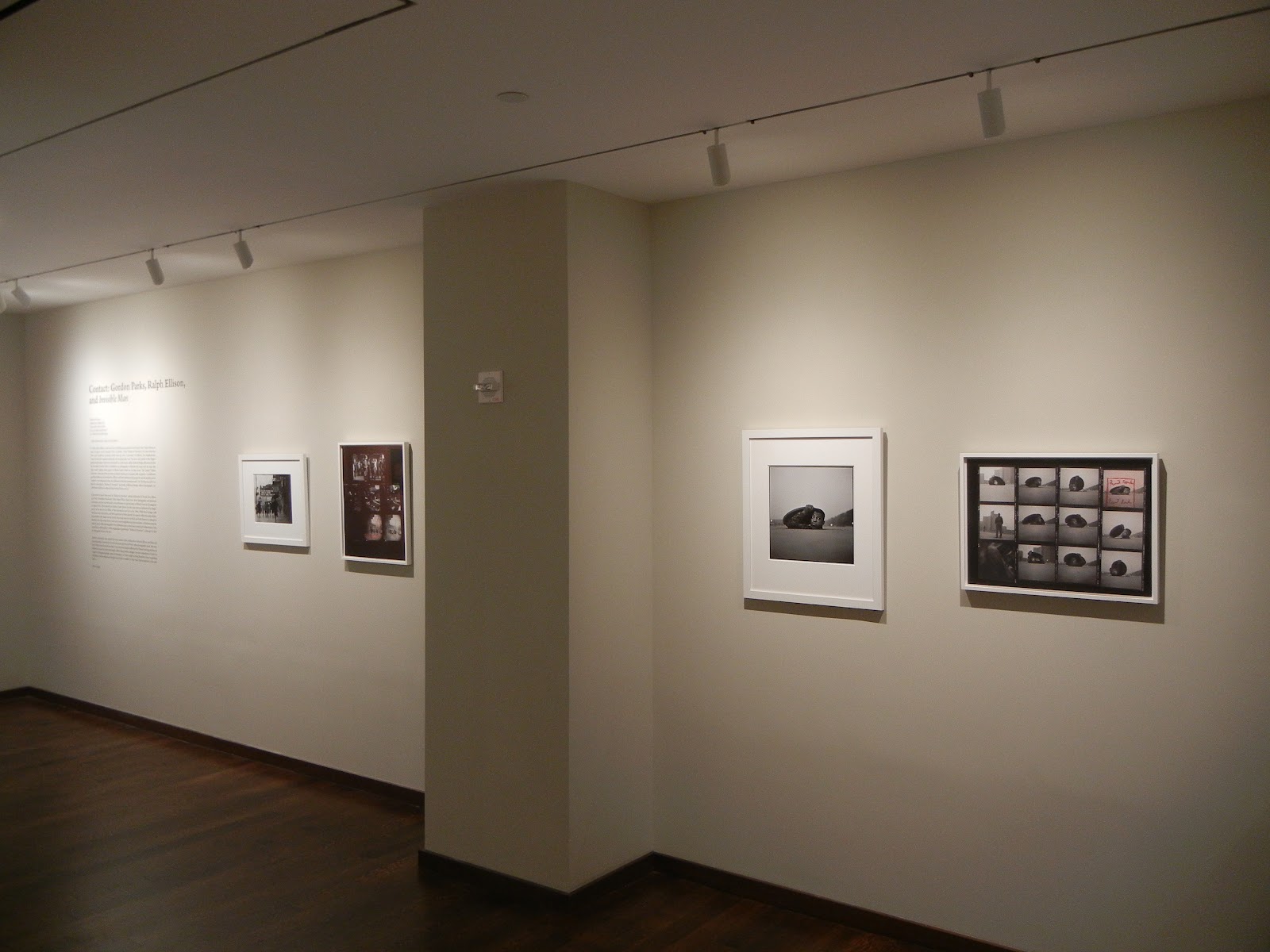 JTF (just the facts): A total of 25 black and white photographs, framed in white and variously matted, and hung in the second gallery space to the left of the main entrance. The show combines prints and contact sheets made between 1948 and 1952; there are 13 individual prints and 12 contact sheets on display. The single images are a mix of vintage gelatin silver prints and more recent pigment prints, sized between 8x10 and 20x16 (or reverse); the later prints are available in editions of 5 or 10. The contact sheets are all recent pigment prints, sized 24x20 (or reverse). The show also includes 3 magazine spreads from LIFE, displayed directly on the wall under plexiglas. (Installation shots at right.)
JTF (just the facts): A total of 25 black and white photographs, framed in white and variously matted, and hung in the second gallery space to the left of the main entrance. The show combines prints and contact sheets made between 1948 and 1952; there are 13 individual prints and 12 contact sheets on display. The single images are a mix of vintage gelatin silver prints and more recent pigment prints, sized between 8x10 and 20x16 (or reverse); the later prints are available in editions of 5 or 10. The contact sheets are all recent pigment prints, sized 24x20 (or reverse). The show also includes 3 magazine spreads from LIFE, displayed directly on the wall under plexiglas. (Installation shots at right.)
Comments/Context: Of all the exhibits dedicated to the work of Gordon Parks on view in the city right now (and there are several), this small show is my favorite. Curated by the artist Glenn Ligon, it primarily examines the images Parks made in 1952 to illustrate some of the scenes from Ralph Ellison's ground-breaking book Invisible Man. The exhibit dives deep into important single images from the project and the related contact sheets that show Parks' artistic process, and then pairs them with more documentary-style street photographs made by Parks in Harlem a few years earlier (again with the associated contact sheets). The result is a show that smoothly moves back and forth between fact and fiction, between real life and literature, all within the context of Parks' compositional eye.
 The images Parks made for Invisible Man have a definite sense of the staged or the imagined. A man peers out from under a manhole cover in the middle of the street with an uncertain, fugitive look in his eye, another works turntables amid a light blub covered underground retreat (complete with superimposed city lights above), and various suited men dash with suitcases on darkened sidewalks. The contact sheets show Parks experimenting with poses and angles, looking for just the right range of quietly surreal tension and contrast.
The images Parks made for Invisible Man have a definite sense of the staged or the imagined. A man peers out from under a manhole cover in the middle of the street with an uncertain, fugitive look in his eye, another works turntables amid a light blub covered underground retreat (complete with superimposed city lights above), and various suited men dash with suitcases on darkened sidewalks. The contact sheets show Parks experimenting with poses and angles, looking for just the right range of quietly surreal tension and contrast.
What's amazing is that many of Parks' street scenes from Harlem exhibit some of these same kind of moments, albeit drawn from everyday life. Pedestrians trudge in the rain under a movie marquee announcing Dealers in Crime and Hoodlum Empire, while lines of abandoned shoes lie on the sidewalk. Most of these photographs document lingering life on stoops and outside storefronts: watching the world go by, yawning, arguing, in front of the Indian herb store or the grocer advertising neck bones. The contact sheets show Parks making multiple exposures of each chosen vignette, refining the spatial relationships until the gestures coalesced.
Seeing these two sets of photographs intermingled, along with their respective outtakes, helped me to see the literary in Parks' street pictures, to understand how his selections from the bustle of life were informed by an aim for a certain tone. His editing wasn't just a search for the cleanest negative or the crispest composition, but was often keyed by an atmospheric connection of some kind; he was looking for something in particular when he was out there with his camera. Overall, not only does this small show deliver some fantastic images, it opens up a window into Parks' working process, which was far more nuanced and complex than I had ever understood.
 Collector's POV: The works in the show are priced as follows. The vintage gelatin silver prints range in price from $8500 to $15000, while the more recent pigment prints are either $5000 or $6500. The contact sheets are $2400 each. Surprisingly, Parks' work is only intermittently available in the secondary markets, and many of his best known works have not come up for sale at auction in a long time. Recent prices have ranged between $1000 and $9000, but this may not be entirely representative of the market for his most iconic photographs.
Collector's POV: The works in the show are priced as follows. The vintage gelatin silver prints range in price from $8500 to $15000, while the more recent pigment prints are either $5000 or $6500. The contact sheets are $2400 each. Surprisingly, Parks' work is only intermittently available in the secondary markets, and many of his best known works have not come up for sale at auction in a long time. Recent prices have ranged between $1000 and $9000, but this may not be entirely representative of the market for his most iconic photographs.
Rating: ** (two stars) VERY GOOD (rating system described here)
Transit Hub:
Through October 27th
Howard Greenberg Gallery
41 East 57th Street
New York, NY 10022
No comments:
Post a Comment